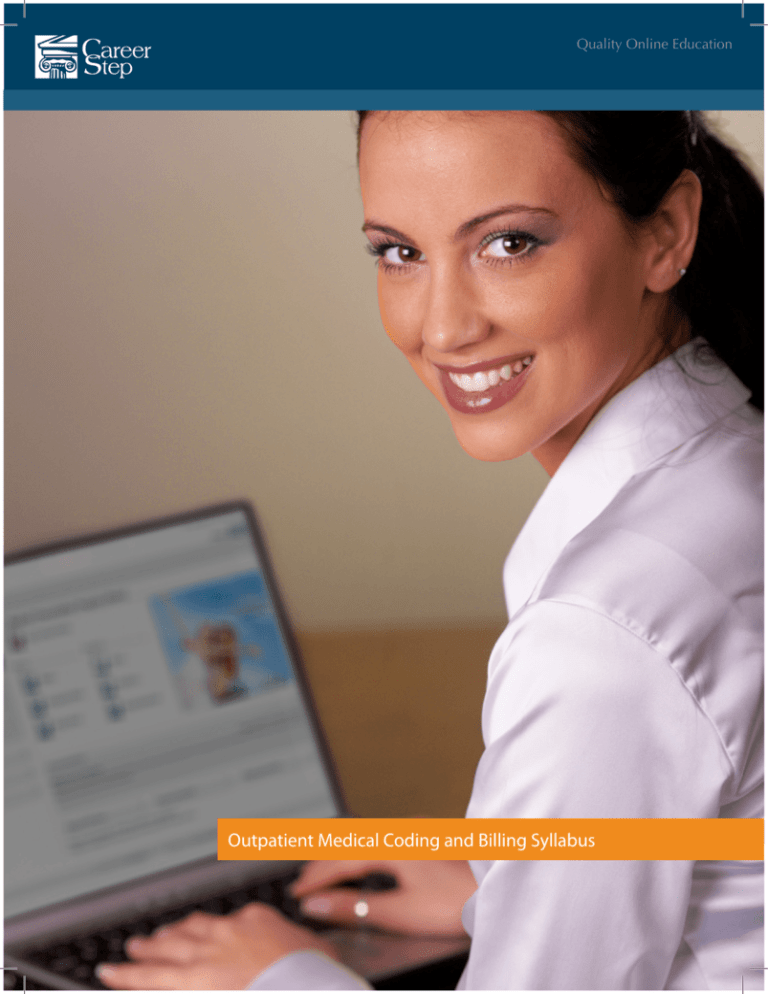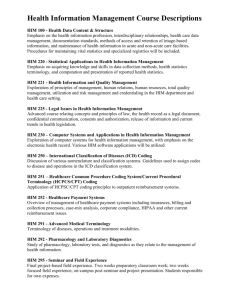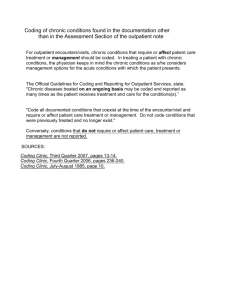
Quality Online Education
Outpatient Medical Coding and Billing Syllabus
Curriculum Description
The Career Step Outpatient Medical Coding and Billing online
training program includes 19 modules and a final exam, all of
which prepare students to work as outpatient coders. Numerous
exercises and skill assessments throughout each module ensure that
students master each skill before moving on to the next concept, and
knowledgeable student support specialists are available to help from
program start to finish.
career opportunities, and certification will be introduced. The coding
systems utilized in the United States will be explored, including
ICD-9-CM, CPT®, HCPCS Level II, DSM-IV, and ICD-O. The future
implementation of ICD-10-CM and ICD-10-PCS will be presented.
Learning and Mastering Medical Terminology – Block 3
In this module, students will learn about medical plurals, medical
slang and jargon, foreign medical terms, word differentiation,
and medical abbreviations. A review of the previous Learning and
Mastering Medical Terminology modules will also be presented.
Program Orientation
Healthcare Structure and Organization
This module provides an overview of training components, instruction
on how to navigate the program, and tips and resources for getting
the most out of the training program. A syllabus is included, outlining
the learning objectives for each module in the program. Information
on navigating, using the features and functions of the online program,
and understanding tests and feedback is presented. Skills necessary
to become a successful medical transcription editor are outlined. The
available resources are also presented along with a detailed study guide
designed to enable a successful learning experience.
In this module, the student will learn about the structure and
organization of the healthcare system in the United States. The student
will study healthcare consumers, healthcare providers, governing and
regulatory agencies, third-party payers, healthcare vendors, and trade
associations.
Technology and the Medical Professional
In this module, the student will become familiar with basic computer
skills, including the use of hardware, software, peripherals, and
wireless technology; use of the Internet as a resource; and use of
various facilities for data storage and networking. The student will
also study the multiple software and hardware products developed
specifically for the healthcare environment.
Learning and Mastering Medical Terminology – Block 1
In this module, the student will learn how to use resources (e.g.
medical dictionaries), how to look up words, how words are
structured, and how medical words use suffixes and prefixes.
Documentation, Confidentiality, and Ethics
This module provides the student with an overview of documentation
and confidentiality requirements within the healthcare environment
and the impact advances in technology have had on the healthcare
profession. The student will become familiar with healthcare
documentation standards, HIPAA compliance regulations, and the
adaptation of the electronic health record (EHR) in institutions
throughout the United States and the world. The student will explore
the role of the medical coding and billing professional in maintaining
the integrity and confidentiality of the medical record.
Learning and Mastering Medical Terminology – Block 2
In this module, the student will begin learning medical word building
through the study of root words. These will be broken down into the
root words A through Ir and Is through X. A review of Learning and
Mastering Medical Terminology - Block 1 will also be presented.
Evolution of Coding in the Healthcare Environment
In this module, the student will learn the history of healthcare coding
in the United States and throughout the world. Learning objectives,
Anatomy, Pathophysiology, and Disease Processes – Block 1
In the first block of Anatomy and Disease, the student will learn basic
anatomical structures, specifically studying the skeletal, muscular,
digestive, respiratory, and reproductive systems. Disease entities,
diagnosis, and treatment will also be emphasized as the student is
introduced to pathophysiology and disease processes. Throughout
this module, illustrations of the various systems and structures will be
included to increase student understanding.
Exploring Pharmacology
This module introduces the student to the science of pharmacology
and provides an overview of basic pharmacologics, including drug
actions and effects, absorption, distribution, metabolism, excretion,
and drug classifications and formulary. This module also gives the
student the opportunity to see and reference pharmaceutical terms in
the context of medical reports with exposure to commonly prescribed
drugs.
Approximate Unit Completion Hours
Program Orientation
1
Technology and the Medical Professional
25
Learning and Mastering Medical Terminology – Block 1
20
Anatomy, Pathophysiology, and Disease Processes – Block 2
Documentation, Confidentiality, and Ethics
20
In the second block of Anatomy and Disease, the student will learn
basic anatomical structures, specifically studying the urinary,
cardiovascular, endocrine, nervous, and integumentary/sensory
systems. The student will also study organs of the body in this module.
As in the previous Anatomy and Disease module, pathophysiology
and disease processes will be emphasized, including disease entities,
diagnosis, and treatment.
Learning and Mastering Medical Terminology – Block 2
20
Evolution of Coding in the Healthcare Environment
15
Learning and Mastering Medical Terminology – Block 3
20
Healthcare Structure and Organization
25
Medical Record Content
Anatomy, Pathophysiology, and Disease Processes –
Block 1
45
Exploring Pharmacology
20
Anatomy, Pathophysiology, and Disease Processes –
Block 2
45
Medical Record Content
15
Diagnostic Coding with ICD-9-CM – Block 1
25
Diagnostic Coding with ICD-9-CM – Block 2
30
Exploring Healthcare Reimbursement
15
Medical Procedural Coding – Block 1
45
Medical Procedural Coding – Block 2
45
Skill Building for Outpatient Coding
138
In the physician-based setting, various reports make up a patient’s
outpatient medical record. This module will provide an overview
and detailed discussion of each of these reports as well as present
the composition of each of the report types and how they relate to
outpatient medical coding and billing.
Diagnostic Coding with ICD-9-CM – Block 1
The students will be introduced to the International Classification
of Diseases, Ninth Revision, Clinical Modification (ICD-9-CM)
codebook. This module gives the student a thorough understanding
of this critical reference book and introduces and explores important
information regarding the general guidelines and several chapterspecific guidelines for coding and reporting outpatient services.
Diagnostic Coding with ICD-9-CM – Block 2
This module continues the detailed instruction of the concepts
presented in the ICD-9-CM codebook and explores the remaining
chapter-specific guidelines and procedure codes for coding and
reporting outpatient services.
Exploring Healthcare Reimbursement
This module provides detailed information about the various types of
payment systems used to reimburse outpatient services. Additionally,
the module introduces information about claims processing, coding,
billing, auditing, and monitoring the coding process.
Medical Procedural Coding – Block 1
In this module, students will be introduced to the Current Procedural
Terminology (CPT®) codebook. This module also provides a thorough
understanding of the structure of the codebook and introduces some
of the critical coding guidelines presented in the text.
Final Exam Overview and Preparation
TOTAL
1
570
Medical Procedural Coding – Block 2
This module continues the detailed instruction of the procedural
codes presented in the Current Procedural Terminology (CPT®)
codebook. It also provides a thorough explanation of the structure and
application of the HCPCS Level II codebook.
Skill Building for Outpatient Coding
This module consists of 500 actual outpatient medical records, which
the student will be required to code. The reports in this module are
drawn from a wide variety of outpatient settings and are divided into
levels of difficulty. The student builds and polishes skills as they work
through increasing levels of complexity.
Final Exam Overview and Preparation
Upon completion of the program, students have the opportunity
to assess their skills through a final exam. This module contains
information about the structure of the exam, tips for passing it, and
how to schedule a time to take it.
Tools for an Unparalleled Learning Experience
Interactive coursework exercises - Coursework
contains hundreds of exercises that help students
review concepts and simulate the professional
outpatient coding and billing experience, giving
them a chance to reflect on their progress.
Intuitive navigation - Simple, intuitive
navigation is quick and easy to learn, so
students can start making real progress from
day one.
Coding & billing practice tools - Students will
train with built-in online tools that allow them
to practice coding and billing procedures on
hundreds of authentic medical records using
real-world resources.
Study planner, grade book, & enhanced security The program offers tools to help students set and
track study goals, chart their progress, see results
from all exercises and tests, and monitor account
access to safeguard their private information.
Images & visual enhancements – Photos,
illustrations, as well as many coding and billing
specific forms, documents, charts, and references
enhance students’ learning experiences.
© 2011 Career Step, LLC. All Rights Reserved
Games & flashcards - Crossword puzzles, word
searches, and flashcards are scattered throughout
the course, so students will learn important
terminology, concepts, and definitions while
having fun!
CareerStep.com • 1-800-411-7073






